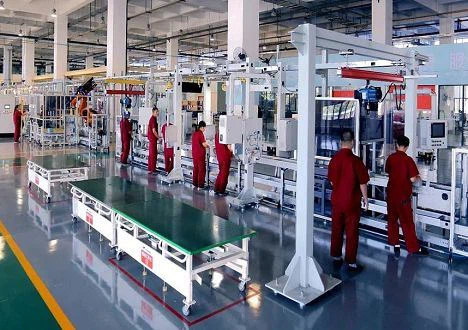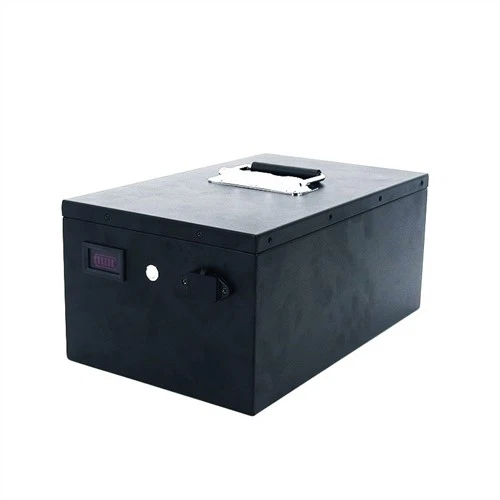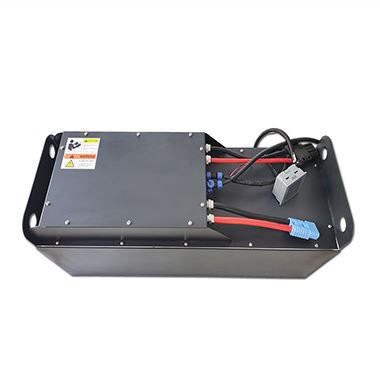
48V400Ah Electric Forklift Battery Pack
What is Electric Forklift Battery Pack?
An electric forklift battery pack is the power source for electric forklifts and electric lift trucks. It's a key component of the equipment that affects the efficiency of operations, and the choice of battery can be important for fleet management.
Why Choose Us
Quality assurance
Out of passion for green energy, United has set up a professional renewable energy team with more than 10 years of experience in the rechargeable lithium-iron battery pack industry.
Good service
You can be sure that you are getting the most competitive battery packs on the market backed by top level customer service.
Reasonable price
The price is reasonable and will bring you different surprises.
Fast delivery
The delivery speed is fast, and the delivery will be sorted out for you as soon as the order is placed.
25.6V 160Ah Lithium Electric Forklift Battery Pack
COMBINE's advanced lithium-ion battery and energy storage uniquely combine the benefits of lithium-ion with Combine Tech's advanced Battery Management System (BMS).
36V 200Ah Lithium-ion Electric Forklift Battery
Combine has optimized the safety and performance of lithium-ion for material handling equipment and other industrial applications.
48V400Ah Electric Forklift Battery Pack
Low downtime and increased productivity starts with a COMBINE Power Motive Power Battery. COMBINE has been a national leader in "Power Solutions" for material handling and transportation industries.
48V404Ah Electric Forklift Battery
Available in a wide range of capacities and sizes, new or used, COMBINE Power delivers quality dependable Power Solutions accessories to best meet your requirements.
48V 500Ah Electric Forklift Battery with BMS
Low downtime and increased productivity starts with a COMBINE Power Motive Power Battery. COMBINE has been a national leader in "Power Solutions" for material handling and transportation industries.
80V 400Ah Industrial Lithium Forklift Battery Pack
Combine has optimized the safety and performance of lithium-ion for material handling equipment and other industrial applications. Our cells are UL/CE tested, and use one of the safest and most...
48V 400Ah Lithium Electric Excavator Battery
COMBINE is leading the way in clean technology and reducing harmful emissions, a new generation of electric products with zero exhaust emissions, greatly reduced noise and no compromise on...
80V 720Ah Lithium-ion Excavator Battery
The future is now for electric construction equipment, and Combine support the Construction Equipment show the latest advancements in emobility.
96V 400Ah LFP Electric Digger Battery
Electric Power Packs takes the proven credentials of the industry's reduction in noise, vibration and heat, ensuring long lasting comfort and productivity. The lack of an exhaust is also...
Batteries are critical components in an electric forklift. You ensure that your trucks are running smoothly, but sometimes the heart of them is overlooked. Your forklift battery's performance and longevity can vary wildly, with the main culprit of low production being poor care and maintenance. While they last an average of five years, you can double the expectancy of your device with regular upkeep. Here's how to keep your electric battery humming for up to a decade.
Undercharging and Overcharging
Proper charging of a forklift battery is critical to maximize its useful life! Both over and under charging can cause serious damage to the battery. Nowadays, overcharging seems to be the larger culprit. Often times, due to a hectic pace in warehouses, drivers will plug the unit in multiple times per day so that the battery is "always full". This is a NO-NO! Each time this occurs, the battery is essentially tricked into thinking it was empty, therefore shorting the life of that particular charge. Proper procedure would be to hold off on putting the battery on charge until there is only 15%-20% of battery life remaining.
Traditional lead acid batteries require a system of 8-8-8 to function at peak efficiency. (8 hours of charge, 8 hours of cooling, then 8 hours of use) If a battery is not making the full 8-hour shift, then adding an additional battery to the mix may be necessary. Another option would be to consider a Fast Charge or Opportunity Charging system. Each of these two options require special battery and charging components, but allow for much quicker charging times, plus they are designed to withstand the rigors of always being "plugged in"!!
Charge It Fully
Forklift batteries aren't cell phones. Charging them in short bursts is not practical, as they have a limited number of total charges in their life. A half-charge takes as much of a toll as a full recharge, so make each one count.
Protect the Battery from Extreme Temperatures
The chemical composition of a battery is somewhat fickle. Power units function best in average temperatures, and too hot or too cold can severely affect your forklift's performance. Extreme heat is especially damaging and can cut short the battery's lifespan by 50%. Be wary while charging as temperatures rise during the process.
Stay Safe when Handling Batteries
Batteries can cause substantial damage if you don't take the correct precautions. They contain sulfuric acid, which can cause severe eye and skin damage. Protective clothing and eye protection are both a must when you service your electric forklift.
Water the Battery Regularly
Many types of batteries, but not all, require watering. They need a thin layer of clean or distilled water - experts recommend a ¼ inch covering - or the units can suffer irreversible damage. Electrolyte levels increase during charging, and the water prevents overflows that may produce overheating or acid erosion.
However, knowing when to add the water is just as critical! Water should NEVER be added prior to charging!!! It should only be added after a complete charge has occurred, AND the battery has had time to cool. In a perfect world, you should charge for 8 hours… then let it cool for 8 hours prior to adding the water. Then, its ready to use!
Keep it Clean
A primary culprit of battery damage, which can increase in damp environments like those we often see in humid climates, is oxidation. Once that layer of rust has appeared on the terminals or tray, it may be too late. To avoid this disaster, make sure you clean the battery frequently with warm water or a cleaning solution and otherwise keep it dry. Cleaning once a month should help your battery last many years. However, without proper cleaning, it can devolve quickly.
Handle With Care
Forklift batteries are dense and heavy. If you attempt to move your vehicle or the battery itself, use specially-designed equipment. A drop can be devastating to the battery and its components. If you do need repairs, don't fret.
Ensure Proper Ventilation when Charging
Chemicals inside batteries can react with each other unpredictably. Leaks, spills, or sudden bursts of smoke can lead to dangerous situations. Besides safeguarding yourself with eyewear, gloves, and protective clothing, you should have proper ventilation. Charging your battery can produce noxious fumes, which can be extremely dangerous in inadequately ventilated spaces.
Your electric forklift is a finely-tuned machine. The individual components work together to power your company's productivity, and the battery is no exception. You can prolong batteries by handling them gently and safely, and keeping a close eye on their condition.
Forklift Battery Sizing
Selecting the right battery size is critical to ensure that your forklift can perform at its peak and lift the load it is rated to lift. There are three parts of battery sizing that you need to look at-
Battery Voltage & Ampere Hour
Forklift batteries are typically available in four voltage options and selecting the right one is the most important part of battery sizing. An oversized battery may cause severe, and irreversible damage to the truck so be sure to know what kind of voltages your truck can handle. Generally, the voltage is marked on the spec plate of most forklifts.
It is advised to choose a battery with the highest ampere-hour for the approved voltage rating to get maximum power for your forklift.
Battery Dimensions
Next, you need to measure the forklift's battery compartment size and make sure that the battery fits in well. The battery needs to fit the compartment properly. A battery that is too big, or too small could pose a safety hazard.
Battery Weight
Check the spec sheet or spec plate to find out the Minimum and Maximum battery weight requirements for the truck. If you pick a battery which is heavier than the maximum weight then you run a risk of putting unnecessary strain on various equipment parts, even voiding the manufacturer's warranty. In many cases, battery also acts as a counterbalance for your truck. A battery lighter than the minimum required weight may reduce your trucks lifting capacity and cause safety issues. When changing the battery on any forklift, a new spec plate may be required to outline the altered capacity of the machine based on any weight change. The battery of an electric forklift acts as a counterweight to the machine and is critical to its lift capacity.
How To Choose the Right Forklift Battery?




Forklift Battery Types
After determining which size battery is compatible with your forklift, the next important consideration is using: lithium-ion vs lead acid forklift batteries.
Electric forklifts are generally powered by either of these two main types of batteries:
Lead acid
Lithium-ion
While there are other power options for forklifts, such as propane or diesel, or gas power, 2/3rds that are put into service each year are electric.
The technology behind each of these industrial batteries differs greatly, and therefore, has a different impact on forklift efficiency.
Lead acid batteries are the old-school standard for powering forklifts. They are bulky, liquid-filled units with a removable top that generates electricity via a chemical reaction of lead plates and sulfuric acid. Its technology goes back to 1859 and involves regularly refilling the units with water (which is also necessary for the electricity-generating chemical processes happening within). Lithium-ion batteries are a newer technology, having been first used in a commercial product in the early 1990s, a Sony camcorder. Lithium-ion batteries have many different chemistries. One of the most popular chemistries for the material handling industry is lithium iron phosphate (LFP). It is more compact and energy dense than lead acid. The cells are sealed shut and require no water maintenance.
Length of a Forklift Battery's Service Life
Like any business expense, electric forklift batteries are a cost that needs to be dealt with regularly.
Which type of battery a company uses in its forklifts determines how often workers will have to replace the battery. Lead acid and lithium-ion batteries have different lifespans:
●Lead acid: 1000 - 1500 cycles
●Lithium-ion: 3000 cycles
These are averages and may vary based on how well the batteries are maintained.
A lithium-ion forklift battery needs to be replaced less frequently, which is a major driver for business owners to prefer them to conventional lead acid batteries – which need to be replaced out for new ones more often.
Maintaining Forklift Battery Capacity
Both lithium-ion batteries and their lead acid counterparts should be cared for properly if they are to perform up to their full potential. Their service life will diminish if proper forklift battery maintenance is not carried out as it should be.
In order to maximize service life and overall battery capacity, certain measures should be taken for users of both battery types. However, lead acid batteries require more care and attention compared to lithium-ion.
Lead acid forklift batteries require:
●Equalizing (Cell Balancing): Traditional technology like this leads to a frequent state where the acid and water inside become stratified (separated horizontally with the acid more concentrated closer to the bottom). This state forms sulfate crystals towards the bottom of the cells and weakens their ability to hold a charge. Equalizing will break up the sulfate crystals but if the battery has been neglected for too long the crystals will not break.
●Temperature Control: Lead acid batteries must be kept within a certain temperature range, or else they will have a shorter working life. On top of that, they also get very hot while charging, which requires them to be charged and stored in a temperature-controlled space.
●Fluid Level Management: These types of units must be checked to ensure they have enough water about once every 10 or so charging cycles.
Lithium-ion batteries are much less needy when it comes to forklift battery maintenance, as they equalize automatically, function well in much higher temperatures (making temperature mostly a non-issue), and do not require any fluid level management.
Forklift Battery Charging Station Requirements
The physical location of your forklift battery charger system is a much bigger consideration than many business owners realize.
Lead acid batteries have specific forklift battery charging station requirements that lithium-ion battery packs do not. After all, lithium-ion battery packs are plugged straight into a charger, and they do not need to be removed from the lift truck to start recharging. There are not really any further actions that need to be taken in order to do a simple recharge.
With lead acid forklift batteries, however, the units must be removed from the vehicle completely and placed onto a separate forklift battery charger – Many of which have the ability to perform equalization. If there are many forklifts in operation, then there will need to be multiple chargers as well as a space for multiple units to cool down after fully recharging. This will involve employees having to use special lift equipment to pick up discharged batteries and drop in charged batteries on a regular basis. While it is not physically straining the task is time-consuming to operations wanting to be more productive.
Lead acid batteries need a dedicated charging space that ventilates and controls the temperature in the room. This is because lead acid batteries can get very hot while charging, producing harmful fumes.
Lithium-ion forklift batteries do not need a separate space, do not need to cool down, and do not require a fully-charged spare at the ready when another one fully discharges – It can be recharged on the spot.
It's crucial to regularly water lead-acid batteries to ensure that deionized or distilled water covers the battery plates. Regularly watering lead-acid batteries helps maintain proper electrolyte levels. A lead-acid battery can typically last five or more years with proper watering.
AGM batteries don't require watering because their electrolytes are suspended in a dry state. Lithium-ion batteries also require no watering, but you should always ensure forklift operators know to keep this type of battery out of high heat and avoid storing it on a full charge.
In addition to watering, all types of forklift batteries require inspections, cleaning and equalizing. Eliminate chemical buildup by thoroughly cleaning the top of each battery once a month. Equalize your forklift batteries once per week, overcharging them to mix electrolytes, remove plate sulfation and balance cells.


You should also visually inspect the battery's connectors and cables regularly. Replace missing parts or contact a professional if you notice any of the following during inspection:
Cracked or deformed connectors
Broken connectors
Exposed wire cables
Worn cable tips
Degraded intercell connectors
Cuts, rust or corrosion on the protective cases
Missing vent caps
7 Reasons to Use Lithium-ion Batteries in Electric Forklifts
Less maintenance, lower costs, environmental sustainability, and overall worker satisfaction are a few key benefits of using next-generation lithium-ion batteries (sometimes called LIBs) in forklifts.
Why Are Lithium-ion Batteries Best for Forklifts?
These batteries offer a broad range of advantages for many warehouses and distribution centers because of the ease of charging. Opportunity charging provides the ability to plug in the battery without taking it out of the forklift, as opposed to swapping batteries its lead-acid counterpart requires.
High-throughput operations tend to see the biggest bang for their buck when using lithium-ion batteries, but the benefits are broader than just the return on investment. As the technology behind these batteries advances, we see a broader range of companies using them.
Benefits of Using a Lithium-ion Forklift Battery
Here are the 7 biggest reasons for your company to explore using lithium-ion batteries:
●Improved Energy Bills
Lithium-ion forklift batteries are more energy-efficient and charge faster than lead-acid batteries, saving you time and money.
●Equipment Longevity
Your lithium-ion battery will typically last two to four times longer than a lead- acid battery. This helps you keep up with those long workdays.
●Less Downtime
Lithium-ion batteries don't need to be swapped out and can be opportunity-charged during operator breaks.
●Reduced Labor Costs
Lithium-ion forklift batteries don't require traditional maintenance like watering or equalizing.
●Better Productivity
Operators can enjoy longer run-times and zero decline in performance as the battery discharges with forklifts powered by lithium-ion batteries.
●Less Environmental Impact
Lithium-ion batteries have no emissions and their longevity may mean less battery disposal in the future.
●Onsite Real Estate
Businesses can reclaim the area being used as a charging room for additional storage.
Our Factory
Here at Combine New Energy, green energy is more than just a trend. We are devoted to creating a new standard in energy storage. Our goal is to enable the widespread deployment of this cutting-edge technology to make green, renewable energy available for everyone. Combine LiFePO4 battery packs are made from 100% safe, nontoxic, renewable energy that can be charged and discharged repeatedly. Our packs are built to last for years. You can be sure that you are getting the most competitive battery packs on the market backed by top level customer service.




FAQ
Previous
No InformationYou Might Also Like
Send Inquiry



















